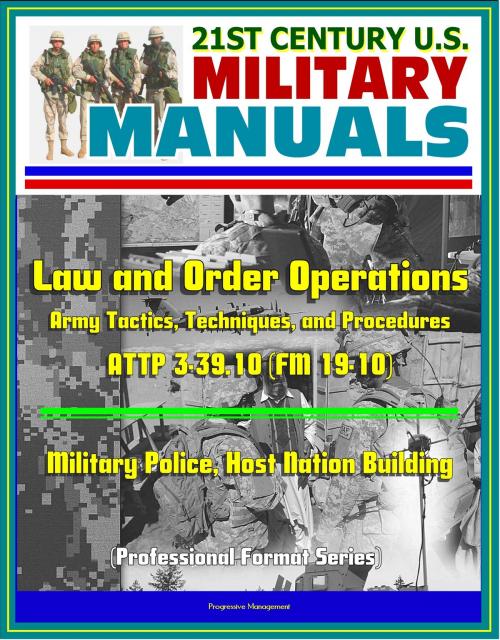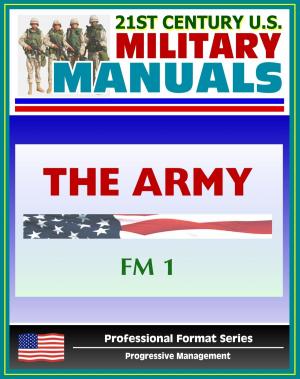21st Century U.S. Military Manuals: Law and Order Operations - Army Tactics, Techniques, and Procedures ATTP 3-39.10 (FM 19-10) - Military Police, Host Nation Building (Professional Format Series)
Nonfiction, Social & Cultural Studies, Political Science, Politics, Law Enforcement, Social Science, Crimes & Criminals, Criminology| Author: | Progressive Management | ISBN: | 9781301757848 |
| Publisher: | Progressive Management | Publication: | November 27, 2012 |
| Imprint: | Smashwords Edition | Language: | English |
| Author: | Progressive Management |
| ISBN: | 9781301757848 |
| Publisher: | Progressive Management |
| Publication: | November 27, 2012 |
| Imprint: | Smashwords Edition |
| Language: | English |
Professionally converted for accurate flowing-text e-book format reproduction, this Army Field Manual provides guidance for commanders and staffs on military police law and order (L&O) operations. L&O operations support all elements of full spectrum operations (offensive, defensive, and stability or civil support operations). This manual emphasizes policing capabilities necessary to establish order and subsequent law enforcement (LE) operations that enable successful establishment, maintenance, or restoration of the rule of law. While this manual focuses on the L&O function and its associated tasks and principles, it also emphasizes the foundational role that L&O operations and policing, in general, play in the military police approach to missions and support to commanders. The L&O function is the lead function of military police, shaping the approach of military police and providing the foundation on which the other military police functions are conducted.
Chapter 1 * LAW AND ORDER AND THE OPERATIONAL ENVIRONMENT * Operations Framework * Operations Across the Spectrum of Conflict * Support of Full Spectrum Operations * Chapter 2 * PLANNING CONSIDERATIONS FOR LAW AND ORDER OPERATIONS * Policing Principles * Policing Models and Strategies * Organization * Operational Capabilities * Planning Considerations * Law and Order Support * Crime and Crime-Reporting Categories * Chapter 3 * POLICE STATION OPERATIONS * Mission Command of Army Law Enforcement Assets * Management of Police Information * Measures for Establishing and Maintaining Law and Order * Law Enforcement Activities and Methods . * Chapter 4 * LAW ENFORCEMENT PATROL OPERATIONS * Law Enforcement Patrols * Patrol Methods * Law Enforcement Patrol Strategies * Traffic Enforcement and Investigations * Criminal Investigations * Interviews and Law Enforcement Interrogations * Searches and Seizures * Apprehension by Army Law Enforcement * Report Writing * Court Testimony * Chapter 5 * POLICE ENGAGEMENT * Military Police Operations * Planning and Coordination * Collaboration and Fusion * Chapter 6 * MILITARY POLICE TRAFFIC OPERATIONS * Traffic Operations * Planning * Traffic Control * Traffic Enforcement * Traffic Accident Investigations * Chapter 7 * BUILDING HOST NATION POLICE CAPABILITY AND CAPACITY * Civil Control * Security Force Assistance * Reconstitution of Host Nation Police Forces * Mission Command Considerations * Military Police Actions in Host Nation Police Building * Recruitment and Training * Key Support Functions * Appendix A * AUTHORITY AND JURISDICTION * Appendix B * CONSIDERATIONS FOR POLICE STATION CONSTRUCTION * Appendix C * EVIDENCE AND FORENSICS SUPPORT * Appendix D * CUSTOMS AND BORDER CONTROL * Appendix E * LAW ENFORCEMENT PATROL AND MANPOWER REQUIREMENTS * Appendix F * CRIME PREVENTION * Appendix G * EQUIPMENT REQUIREMENTS * Appendix H * SPECIAL-RESPONSE CONSIDERATIONS * GLOSSARY * REFERENCES
As a bonus, this reproduction includes the complete 2012 Army Leadership manual (FM 6-22), which describes the Army's view of leadership, outlines the levels of leadership (direct, organizational, and strategic), and describes the attributes and core leader competencies across all levels. The principal audience for ADRP 6-22 is all leaders, military and civilian. Trainers and educators throughout the Army will also use this publication. Commanders, staffs, and subordinates ensure their decisions and actions comply with applicable United States, international, and, in some cases, host-nation laws and regulations. Commanders at all levels ensure their Soldiers operate in accordance with the law of war and the rules of engagement.
Professionally converted for accurate flowing-text e-book format reproduction, this Army Field Manual provides guidance for commanders and staffs on military police law and order (L&O) operations. L&O operations support all elements of full spectrum operations (offensive, defensive, and stability or civil support operations). This manual emphasizes policing capabilities necessary to establish order and subsequent law enforcement (LE) operations that enable successful establishment, maintenance, or restoration of the rule of law. While this manual focuses on the L&O function and its associated tasks and principles, it also emphasizes the foundational role that L&O operations and policing, in general, play in the military police approach to missions and support to commanders. The L&O function is the lead function of military police, shaping the approach of military police and providing the foundation on which the other military police functions are conducted.
Chapter 1 * LAW AND ORDER AND THE OPERATIONAL ENVIRONMENT * Operations Framework * Operations Across the Spectrum of Conflict * Support of Full Spectrum Operations * Chapter 2 * PLANNING CONSIDERATIONS FOR LAW AND ORDER OPERATIONS * Policing Principles * Policing Models and Strategies * Organization * Operational Capabilities * Planning Considerations * Law and Order Support * Crime and Crime-Reporting Categories * Chapter 3 * POLICE STATION OPERATIONS * Mission Command of Army Law Enforcement Assets * Management of Police Information * Measures for Establishing and Maintaining Law and Order * Law Enforcement Activities and Methods . * Chapter 4 * LAW ENFORCEMENT PATROL OPERATIONS * Law Enforcement Patrols * Patrol Methods * Law Enforcement Patrol Strategies * Traffic Enforcement and Investigations * Criminal Investigations * Interviews and Law Enforcement Interrogations * Searches and Seizures * Apprehension by Army Law Enforcement * Report Writing * Court Testimony * Chapter 5 * POLICE ENGAGEMENT * Military Police Operations * Planning and Coordination * Collaboration and Fusion * Chapter 6 * MILITARY POLICE TRAFFIC OPERATIONS * Traffic Operations * Planning * Traffic Control * Traffic Enforcement * Traffic Accident Investigations * Chapter 7 * BUILDING HOST NATION POLICE CAPABILITY AND CAPACITY * Civil Control * Security Force Assistance * Reconstitution of Host Nation Police Forces * Mission Command Considerations * Military Police Actions in Host Nation Police Building * Recruitment and Training * Key Support Functions * Appendix A * AUTHORITY AND JURISDICTION * Appendix B * CONSIDERATIONS FOR POLICE STATION CONSTRUCTION * Appendix C * EVIDENCE AND FORENSICS SUPPORT * Appendix D * CUSTOMS AND BORDER CONTROL * Appendix E * LAW ENFORCEMENT PATROL AND MANPOWER REQUIREMENTS * Appendix F * CRIME PREVENTION * Appendix G * EQUIPMENT REQUIREMENTS * Appendix H * SPECIAL-RESPONSE CONSIDERATIONS * GLOSSARY * REFERENCES
As a bonus, this reproduction includes the complete 2012 Army Leadership manual (FM 6-22), which describes the Army's view of leadership, outlines the levels of leadership (direct, organizational, and strategic), and describes the attributes and core leader competencies across all levels. The principal audience for ADRP 6-22 is all leaders, military and civilian. Trainers and educators throughout the Army will also use this publication. Commanders, staffs, and subordinates ensure their decisions and actions comply with applicable United States, international, and, in some cases, host-nation laws and regulations. Commanders at all levels ensure their Soldiers operate in accordance with the law of war and the rules of engagement.















